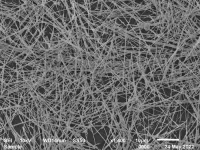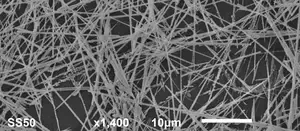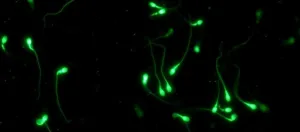(Press-News.org) For the first time, a physical neural network has successfully been shown to learn and remember ‘on the fly’, in a way inspired by and similar to how the brain’s neurons work.
The result opens a pathway for developing efficient and low-energy machine intelligence for more complex, real-world learning and memory tasks.
Published today in Nature Communications, the research is a collaboration between scientists at the University of Sydney and University of California at Los Angeles.
Lead author Ruomin Zhu, a PhD student from the University of Sydney Nano Institute and School of Physics, said: “The findings demonstrate how brain-inspired learning and memory functions using nanowire networks can be harnessed to process dynamic, streaming data.”
Nanowire networks are made up of tiny wires that are just billionths of a metre in diameter. The wires arrange themselves into patterns reminiscent of the children’s game ‘Pick Up Sticks’, mimicking neural networks, like those in our brains. These networks can be used to perform specific information processing tasks.
Memory and learning tasks are achieved using simple algorithms that respond to changes in electronic resistance at junctions where the nanowires overlap. Known as ‘resistive memory switching’, this function is created when electrical inputs encounter changes in conductivity, similar to what happens with synapses in our brain.
In this study, researchers used the network to recognise and remember sequences of electrical pulses corresponding to images, inspired by the way the human brain processes information.
Supervising researcher Professor Zdenka Kuncic said the memory task was similar to remembering a phone number. The network was also used to perform a benchmark image recognition task, accessing images in the MNIST database of handwritten digits, a collection of 70,000 small greyscale images used in machine learning.
“Our previous research established the ability of nanowire networks to remember simple tasks. This work has extended these findings by showing tasks can be performed using dynamic data accessed online,” she said.
“This is a significant step forward as achieving an online learning capability is challenging when dealing with large amounts of data that can be continuously changing. A standard approach would be to store data in memory and then train a machine learning model using that stored information. But this would chew up too much energy for widespread application.
“Our novel approach allows the nanowire neural network to learn and remember ‘on the fly’, sample by sample, extracting data online, thus avoiding heavy memory and energy usage.”
Mr Zhu said there were other advantages when processing information online.
“If the data is being streamed continuously, such as it would be from a sensor for instance, machine learning that relied on artificial neural networks would need to have the ability to adapt in real-time, which they are currently not optimised for,” he said.
In this study, the nanowire neural network displayed a benchmark machine learning capability, scoring 93.4 percent in correctly identifying test images. The memory task involved recalling sequences of up to eight digits. For both tasks, data was streamed into the network to demonstrate its capacity for online learning and to show how memory enhances that learning.
DOWNLOAD photos or multimedia at this link.
INTERVIEWS
Professor Zdenka Kuncic Ruomin Zhu (speaks English + Chinese)
zdenka.kuncic@sydney.edu.au rzhu0837@uni.sydney.edu.au
MEDIA ENQUIRIES
Marcus Strom | Science Media Adviser | +61 474 269 459 | marcus.strom@sydney.edu.au
RESEARCH
Zhu, Lilak, Loeffler, et al (Nature Communications, 2023)
‘Online dynamical learning and sequence memory with neuromorphic nanowire networks’
DOI: 10.1038/s41467-023-42470-5
DECLARATION
Zdenka Kuncic, Adam Stieg and James Gimzewski are with Emergentia Inc. Ruomin Zhu and Alon Loeffler are supported by research scholarships at the University of Sydney. Zdenka Kuncic acknowledges support from the Australian-American Fulbright Commission.
END
Nanowire ‘brain’ network learns and remembers ‘on the fly’
Critical step passed for developing agile, low-energy machine intelligence
2023-11-01
ELSE PRESS RELEASES FROM THIS DATE:
Epigenetic signature for obesity found in study of twins
2023-11-01
PULLMAN, Wash. – A susceptibility to gain weight may be written into molecular processes of human cells, a Washington State University study indicates.
The proof-of-concept study with a set of 22 twins found an epigenetic signature in buccal or cheek cells appearing only for the twins who were obese compared to their thinner siblings. With more research, the findings could lead to a simple cheek swab test for an obesity biomarker and enable earlier prevention methods for a condition that effects 50% of U.S. adults, the researchers said.
“Obesity appears to be more complex than simple consumption of food. Our work indicates there’s a susceptibility for this disease ...
Mobile phone use may affect semen quality
2023-11-01
Does electromagnetic radiation emitted by mobile phones affect semen quality? While various environmental and lifestyle factors have been proposed to explain the decline in semen quality observed over the last fifty years, the role of mobile phones has yet to be demonstrated. A team from the University of Geneva (UNIGE), in collaboration with the Swiss Tropical and Public Health Institute (Swiss TPH), has published a major cross-sectional study on the subject. It shows that frequent use of mobile phones is associated with a lower sperm concentration and total sperm count. However, researchers did not ...
Study finds JAK inhibitors, common treatment for arthritis, are effective
2023-11-01
According to a new paper in Rheumatology, published by Oxford University Press, JAK inhibitors, which doctors have used to treat patients with arthritis despite concerns about the effectiveness of such drugs, actually do work quite well. In a multicenter, retrospective study Japanese researchers found that the drugs resulted in impressive remission rates in patients, most of whom choose to continue such treatment.
Rheumatoid arthritis is a common autoimmune disease characterized by chronic inflammation of joint linings and results in progressive joint destruction and other systemic ...
Do mild depressive and anxiety symptoms in fathers predict behavioral and cognitive problems in their children?
2023-11-01
While the role of mothers’ stress, anxiety and depression on children’s behavioral and cognitive development is well established, less is known about the connection between fathers’ mental health and children’s development.
Now, a team of researchers affiliated to different institutions across Quebec, Canada has examined if paternal anxious and depressive symptoms, measured during their partner’s pregnancy, and again six to eight years later, are associated with children’s cognitive function and behavior. They studied this association ...
Cancer drug could hold hope for treating inflammatory diseases including gout and heart diseases
2023-11-01
A cancer drug currently in the final stages of clinical trials could offer hope for the treatment of a wide range of inflammatory diseases, including gout, heart failure, cardiomyopathy, and atrial fibrillation, say scientists at the University of Cambridge.
In a study published today in the Journal of Clinical Investigation, the researchers have identified a molecule that plays a key role in triggering inflammation in response to materials in the body seen as potentially harmful.
We are born with a defence system known as innate immunity, which acts as the first line of defence against harmful materials in the body. Some of these materials will come from outside, such as bacterial or viral ...
New cancer drug shows promise targeting genetic weakness in tumors, comments Virginia Tech expert
2023-11-01
Imagine the body’s cells are well-behaved students in the classroom. The “teachers” are tumor suppressor genes, and they make sure cells follow the rules. But when tumor suppressor genes are away, cells may go astray.
With cells, this is a serious matter. Unregulated behavior can lead to uncontrolled growth and, ultimately, the development of cancer.
In an invited review article Wednesday (Nov. 1, 2023) in Cancer Discovery, a journal of the American Association for Cancer Research, Kathleen Mulvaney, assistant professor with the Fralin Biomedical Research Institute at VTC, talks about the ...
Marine oxygen landscape shaped by plate movement and biological innovation
2023-11-01
The oxygen content of seawater has a profound impact on the cycling of bioessential elements and the habitability of Earth. But how and why the marine oxygen landscape (i.e., the spatial pattern of oxygen levels) evolved since the start of the Phanerozoic 538 million years ago is not well established.
To tackle this problem, researchers led by Prof. WANG Xiangli from the Institute of Geology and Geophysics of the Chinese Academy of Sciences (IGGCAS) and Prof. LI Chao from the Chengdu University of Technology, along with collaborators from the University of Cincinnati and the Nanjing Institute of Geology and Palaeontology, have reconstructed a nearly continuous record of ...
Having a bad boss makes you a worse employee
2023-11-01
uIf your boss stomps and yells, criticizes you, and then proceeds to take the credit for your work – even it is an isolated incident – it can take a profound toll on employee well-being and performance. But despite the many years of research, the precise mechanisms through which bad leadership impacts employees’ performance remain a subject of interest.
In a new study, first published online Oct. 30 in Group & Organization Management, an international group of researchers, led by Stevens Institute of Technology and University of Illinois Chicago, offer a novel explanation of the cognitive factors through which abusive ...
Non-invasive technology maps brain activity to investigate behavior changes in neurological disease
2023-11-01
A research team led by Cleveland Clinic and Oregon Health and Science University (OHSU) has developed a new method for mapping how the parts of the brain "speak" to each other, critical to understanding behavior changes in patients with neurological disease.
Diseases like Alzheimer's disease change how patients communicate and act, affecting their relationships and well-being. Cleveland Clinic's Hod Dana, PhD, is collaborating with Jacob Raber, PhD, an OHSU behavioral neuroscientist, on ...
NIH funding helps Ghose Lab invest in innovative imaging equipment
2023-11-01
UTA will soon add a new piece of cutting-edge equipment to its already impressive and growing research armamentarium—a type of super-resolution microscope (SRM) that allows biologists to see structures within a cell in even finer detail.
The SRM will come to UTA because of additional grant funding from the National Institutes of Health (NIH) to the lab of Piya Ghose, an assistant professor of biology at UTA. This nearly $250,000 award supplements Ghose’s existing NIH/National Institute of General Medical ...
LAST 30 PRESS RELEASES:
Orthopedics can play critical role in identifying intimate partner violence
Worms as particle sweepers
Second spider-parasitic mite described in Brazil
January 2026 issues of APA journals feature new research on autism, pediatric anxiety, psychedelic therapy, suicide prevention and more
Private equity acquired more than 500 autism centers over the past decade, new study shows
New cervical cancer screening guidelines from the US Department of Health and Human Services
Estimated burden of COVID-19 illnesses, medical visits, hospitalizations, and deaths in the US from October 2022 to September 2024
Smartphone use during school hours by US youth
Food insecurity and adverse social conditions tied to increased risk of long COVID in children
Earliest, hottest galaxy cluster gas on record could change our cosmological models
Greenland’s Prudhoe Dome ice cap was completely gone only 7,000 years ago, first GreenDrill study finds
Scientific validity of blue zones longevity research confirmed
Injectable breast ‘implant’ offers alternative to traditional surgeries
Neuroscientists devise formulas to measure multilingualism
New prostate cancer trial seeks to reduce toxicity without sacrificing efficacy
Geometry shapes life
A CRISPR screen reveals many previously unrecognized genes required for brain development and a new neurodevelopmental disorder
Hot flush treatment has anti-breast cancer activity, study finds
Securing AI systems against growing cybersecurity threats
Longest observation of an active solar region
Why nail-biting, procrastination and other self-sabotaging behaviors are rooted in survival instincts
Regional variations in mechanical properties of porcine leptomeninges
Artificial empathy in therapy and healthcare: advancements in interpersonal interaction technologies
Why some brains switch gears more efficiently than others
UVA’s Jundong Li wins ICDM’S 2025 Tao Li Award for data mining, machine learning
UVA’s low-power, high-performance computer power player Mircea Stan earns National Academy of Inventors fellowship
Not playing by the rules: USU researcher explores filamentous algae dynamics in rivers
Do our body clocks influence our risk of dementia?
Anthropologists offer new evidence of bipedalism in long-debated fossil discovery
Safer receipt paper from wood
[Press-News.org] Nanowire ‘brain’ network learns and remembers ‘on the fly’Critical step passed for developing agile, low-energy machine intelligence






